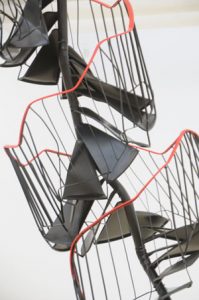Sosnowska arrived in Israel in 2008 through a residency at the Jerusalem Center for Visual Arts (JCVA). As she is engaged in an original and fruitful dialogue with architecture, she was taken on a professional architectural tour of Tel Aviv and its environs. Here, in the White City, no less than in her own Warsaw, Sosnowska found Brutalism and other forms of architecture that thoroughly reflect political choices and social statements. From the wide array of sights she captured in her camera on that tour, the artist selected a photograph she took on Bialik St. as inspiration for the work on view here: a unique hidden spiral staircase attached to the rear of what used to be Tel Aviv’s “City Home.” This staircase, unusual in the eclectic architectural environment, was built in bare-concrete style; its former status was visible through its current wretched state. The stairs had in fact functioned as the emergency staircase of the Museum of Tel Aviv’s History. They were a late, prefabricated attachment to the building in 1971, when it ceased to function as the municipality and became a museum. In 2008, Sosnowska’s photograph unwittingly immortalized the stairs a moment before they were removed when architect Meira Kowalsky restored the original building as part of the White City restorations.
Sosnowska’s first move was to change the directionality of the stairs. Effecting something like a shift in scales from a minor to a major key, she dictates a spiraling upward gaze, which recalls Derrida’s idea of the Tower of Babel “The tower on earth is meant to stretch on high and bridge the gap between the material and the ideal.”
After changing our perspective, the artist applied pressure and compacted the object, giving the sculpture its final shape and autonomy. “The deconstructive search assumes… that every tower must… remain hanging in the air, verging on collapse, so that we may have a history, so that we can breathe, or continue building.” The focus on the stairs’ structure, on the necessary scaffolding, is the basis here, but it is this very structure that in its collapsed state calls out against the ideologies that once glorified totalitarian regimes and of which only ruined monuments remain.
Though it is made of one object alone, with no pedestal, stage or other mediation — its base and its top equally nude — Sosnowska’s piece fills the museum hall for which it was made, and permeates it entirely. The sculpture is homeless and site-less, and penetrates non-space, the “Negative Condition” described by Rosalind Krauss.
On the vertical axis, a perpendicular sculptural object touches and marks the center between floor and ceiling. On the one hand it is crushed and lowered to the hall’s (cube-shaped) proportions, but on the other it seems like a column that holds the space together, prevents collapse and helps the museum “survive.”
The circular motion, which is integral both to the initial, inspirational object and to the action of squashing, creates what Adam Budak called Sosnowska’s “performative installations.” The objects in these installations are characterized by an inherent dynamic force which engenders the sculpture’s unique individuality. The immensity and power of the installation is in the folded condition of this large object, in the chaos created out of order, in the unplanned upheaval that has impacted perfect engineering calculations. Derrida says that “Towers of Babel, swirls of Babel, are philosophical necessities, the necessity of the philosophy that exists in the space between the tower and its collapse.” Sosnowska’s stairway freezes that space and acts as a sign for the way blind ambitions for greatness contain their own potential collapse.
Nirith Nelson, Curator of the exhibition
Less Reading...
